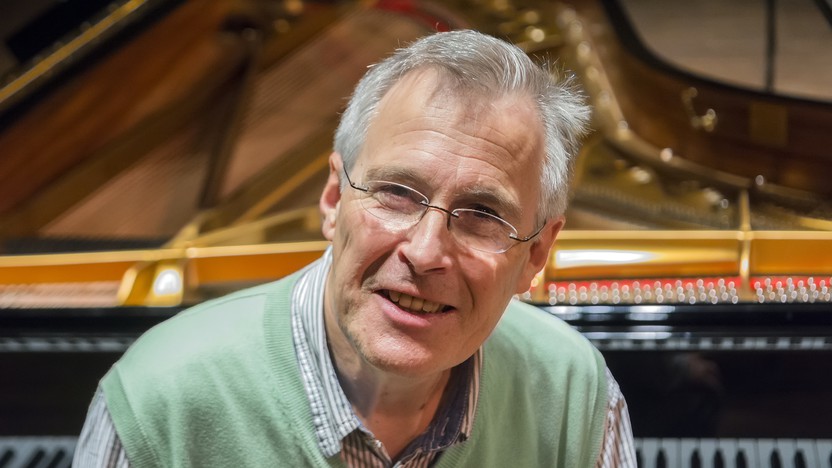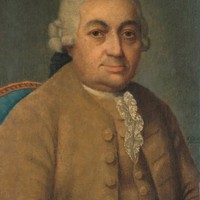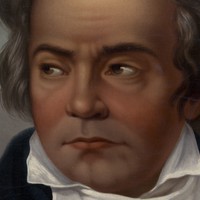Celebrating Christian Zacharias: Beethoven's Piano Concerto No. 4

Sponsored By
- April 29, 2016


Sponsored By


Baroque Song comprises three variations on imaginary chorales, or, more precisely, three methods of variation used by Bach and his contemporaries. The chorale itself (made from a number of vague recollections that have been mixed together with liturgical material removed) serves merely a point of reference.
The first movement launches with a “quick trio,” seemingly derived from of the choral Nun freut euch, lieben Christen gmen, BWV 734 by Johann Sebastian Bach. The initial Baroque material is progressively “penetrated” by interventions that transform, proliferate and increases its complexity, building to its destruction in an explosive finale.
The second movement unfolds with a duality that contrasts a distant memory of the choral Nun komm, der Heiden Heiland (played by a quartet of soloists) with melodic swirls that seem to emerge from arias and cantatas from a hazy and timeless universe. Through weaving together these opposing ideas that give birth to a long progression, the music becomes increasingly ornate (drawing inspiration from the grand declamations important to Kantor), increasingly expressive, and is eventually dominated in the end by the chilling exposition of an imaginary chorale melody.
After a short period of time, amid a “field of ruins” where the chorales seem to float in a halo of string harmonics, a solo cello reprises the expressive aria motifs, and drives them into the third movement. This final energetic section is based primarily on the idea of a fantastic dance canon where the melodic lines respond to each other in an incisive and close manner, similar to the “phasing” style pioneered by Steve Reich and Terry Riley.
Baroque Song reveals three interpretations of Baroque vestiges, where these ancient forms are revisited and given new life using modern composition processes.
Thierry Escaich ©2007

Though best known today as the most prominent of Johann Sebastian Bach’s musical progeny, during his lifetime, Carl Philipp Emanuel Bach in fact enjoyed tremendous recognition in his own right. Indeed, as a composer, he was arguably held in higher esteem than his father, who was primarily known as an organ virtuoso and less so for his compositional achievements. And while Sebastian’s legacy today certainly outweighs Emanuel’s, the latter’s contribution to Western music must not be overlooked.
C.P.E. Bach served as a bridge from the Baroque era to the Classical period. Of his sizeable oeuvre, his symphonies (also referred to as sinfonias) in particular illustrate the transitional chapter of Western music history that he occupied. They mark an early stage in the evolution of the modern Classical symphony, as later crystallized by Haydn and Mozart. More broadly, they offer a musical snapshot of the transition from the learned style of J.S. Bach—long, ornate melodies, intricate counterpoint, dizzying formal complexity—to the eighteenth-century galant style: music featuring simple melodies, lightly accompanied by simple harmonies and homophonic textures.
Yet while the galant style has become associated with light, anodyne music (Voltaire surmised, “Being galant, in general, means seeking to please.”), C.P.E. Bach’s music escapes the banal. He was a Bach, after all. While his Sinfonias dispense with the complexity of his father’s scores in favor of melodic and textural clarity, they nevertheless reflect the keen musical inventiveness of his pedigree.
The Sinfonias in G Major and F Major, Wq. 180 and 181, both composed in 1758 and revised shortly thereafter, are works of complete and at times startling originality. Bach composed the G Major Sinfonia in Berlin, while in the employ of Frederick the Great of Prussia. (It is the second-to-last of his nine “Berlin” Symphonies.) Bach originally composed it for string orchestra, adding pairs of oboes and horns in the later revision. The augmented forces magnify the bright exuberance of the opening movement, carrying radiant melodic lines as an inexorable rush of strings propels the music forward.
The Allegro concludes on an abruptly introspective note and proceeds directly to the gloomy second movement. The Largo’s operatic character contains a whisper of J.S. Bach’s arioso writing—think of the magnificent “Erbarme dich” from the Saint Matthew Passion—but unfettered by the Baroque master’s ornamental figures and contrapuntal textures. The movement vacillates between weary legato utterances and aggressive dotted-rhythm unisons, prefiguring the Sturm-und-Drang aesthetic of the Romantic generation. (The astute listener might note a slight resemblance to the slow movement of Beethoven’s Fourth Piano Concerto, which concludes this program.) The Sinfonia’s concluding Allegro assai makes a victorious return to the first movement’s sunny optimism.
The Sinfonia in F Major follows the same three-movement scheme as the G Major. A mischievous, bull-in-china-shop melodic idea launches the opening Allegro. Bach’s obsession with this barreling sixteenth-note triplet figure powers the entire movement, foreshadowing Beethoven’s technique of motivic development.
The Allegro movement’s highly caffeinated energy eases for the gentle Andante. The introduction of flutes signals a striking change in atmosphere. (Like the G Major, the F Major Sinfonia was originally scored for strings; Bach added winds when revising the work in 1762.) Beneath the gossamer texture, repeated notes in the bass set a vaguely ominous tone. Dour melodic turns, stated in unison by the strings (and distantly echoing the opening Allegro’s central motivic figure), punctuate the flutes’ featherweight phrases. But just as the fog seems to have settled for good, the Andante explodes attacca into the extroverted finale.
Patrick Castillo ©2016
 Watch Video
Watch Video
On December 22, 1808, Beethoven presented a remarkable concert in Vienna. The four-hour extravaganza featured the public debuts of the Fifth and Sixth Symphonies, the Fourth Piano Concerto and the Choral Fantasy (composed as a showstopper for the occasion), as well as miscellaneous excerpts from the Mass in C, a rendition of the concert aria Ah! Perfido and some piano improvisations. Reports from the concert bemoaned the glut of music, the hall’s frigid temperature and a sloppy orchestra; the Choral Fantasy actually ground to a complete halt, at which point Beethoven returned to the beginning and prolonged the concert even further.
The Fourth Piano Concerto left spectators particularly baffled, and the work remained largely untouched until Felix Mendelssohn revived it in 1836. The mystery begins when the piano enters alone, spinning out a simple harmonic progression marked piano dolce (quiet and sweet). Then, after the piano leaves a chord hanging that by all expectations would resolve back to a stable point of arrival, the soloist withdraws and the strings enter in a totally foreign and exotic new key. Unexpected harmonic transitions continue to crop up throughout the first movement, keeping with the quizzical mood established at the outset.
In the central Andante con moto, a single line, scored across several octaves in the strings, engages the piano in a halting tête-à-tête in E minor. The final cadence flows directly to the Rondo finale, which again starts with just a whisper. The strings take the lingering memory of the pitch E as the start of the galloping tune, stating the theme first and then passing it to the piano. The melody begins with a repeated tone and an ascending arpeggio that anchors our ears in C major—except the actual destination of this concerto is to return to its starting key of G major. Amazingly, this main theme of the finale never begins in the “proper” key, even when it appears moments from the end, adding to the sense of sleight-of-hand that defines this most elusive of Beethoven’s piano concertos.
— © Aaron Grad
Aaron Grad ©2017
Get driving directions and find nearby parking.
Find dining options close to the venue.
View seating charts to find out where you'll be seating.
Get driving directions and find nearby parking.
Find dining options close to the venue.
View seating charts to find out where you'll be seating.
